|
Working Today
to Preserve Tomorrow
We are now on facebook!! A great chance to ask questions and give us your thoughts and ideas about conservation.

|
 |
Donate to Northern Prairies
via PayPal
|
 |
Read about conservation easements and enhanced tax incentives under
"Tools and FAQ's"
|
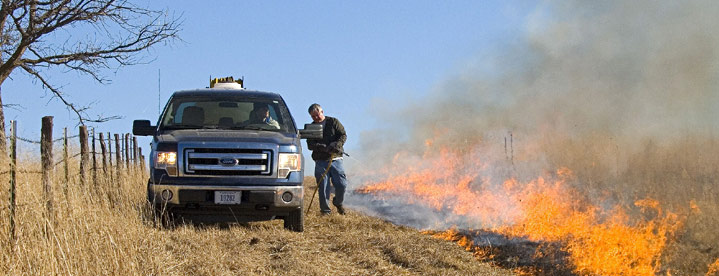
PRAIRIES ARE AMONG THE MOST THREATENED ECOSYSTEMS IN NORTH AMERICA. Most remaining prairies are privately owned, making cooperation between landowners and conservationists essential for their preservation.
Consequently, in 2002, Northern Prairies Land Trust entered into a cooperative relationship with the Nebraska Game & Parks Commission to implement habitat improvement projects on privately owned prairies. Our initial work was focused in areas that are now called the Sandstone Prairies Biologically Unique Landscape (BUL) and Southeast Prairies BUL in southeast Nebraska. We subsequently extended our prairie-focused work to the Verdigris-Bazile, the Middle Niobrara River Valley, and Keya Paha Watershed BULs in northeast Nebraska. Over the past fifteen years, using funding from a series of successful NPLT grant proposals to the Nebraska Environmental Trust combined with funding from the US Fish and Wildlife Service and the Nebraska Game and Parks Commission, we have worked with over 300 landowners to enhance nearly 90,000 acres of grassland, primarily through implementation of invasive tree clearing, prescribed fire, planned grazing and high diversity seeding.
Starting in 2009, we also began to focus some of effort on the oak woodlands that rim the eastern side of Nebraska. Similarly to prairies, oak woodlands and savannas have experienced massive declines over the past century and the remnants are degrading due to lack of appropriate management. We are spearheading large scale restoration efforts at Ponca State Park and Indian Cave State Park involving prescribed fire and invasive species control. In addition, we have completed more than two dozen habitat improvement projects on over 5,000 acres of privately owned oak woodlands.
CONGRESS ENDORSES INCOME TAX INCENTIVES FOR LAND CONSERVATION
In a great victory for landowners, the enhanced tax incentive for conservation easements has been made permanent.
This short brochure summarizes the conservation easement tax incentive and provides answers to some frequently asked questions.
NORTHERN PRAIRIES LAND TRUST PLAYS KEY ROLE IN EXPANDING BISON RANGE IN BADLANDS NATIONAL PARK
As the result of a complex land exchange in which Northern Prairie played a key role, 30,000 additional acres of bison range has been added in Badlands National Park, allowing for the expansion of the bison herd to about 1,000 head – the size recommended as a minimum for maintaining genetic diversity. The exchange has been described as one of the most important events in Park history, and a huge step forward in protecting native grasslands species of all kinds.
On June 11, John Davidson, President of Northern Prairies, joined with other conservation partners and the National Park Service in a formal “fence-cutting” ceremony, celebrating the opening of the new lands to the roaming bison herd. Photos of the ceremony are shown here.
The project is just one of the many through which Northern Prairies plays a quiet but critical role in advancing prairie conservation.

.
ONE PROPERTY AT A TIME-- REINVENTING CONSERVATION -- A REPORT FROM THE FIELD
John Davidson
The goal of Northern Prairies Land Trust is to establish partnerships with landowners to provide protection for lands that are important for agriculture, forestry, fish and wildlife habitat and open space. During its early years, Northern Prairies developed expertise using various conservation tools to help landowners protect in perpetuity the natural values of their land. This capacity resulted in conservation easements protecting thousands of acres.
Northern Prairies also sought opportunities to advance private lands conservation in other ways. Being open to innovation it is now achieving conservation on a landscape scale. Allow me to describe some of our work.
In the 1990s, the Nebraska Game & Parks agency completed a study, known as the Nebraska Natural Legacy Project, which provides a fresh blueprint for action. Recognizing that priorities are needed, it identifies some 40 “Biologically Unique Landscapes” (now referred to as “BULs”) -- areas that represent the best opportunities to protect at-risk species of plants, animals and insects. However, identifying priority areas is just a first step, and the next question was how to go about protecting BUL lands, almost all of which are in private ownership.
Seizing an opportunity, Northern Prairies Land Trust formed a partnership with Nebraska Game & Parks, and implemented a plan. Simply stated, we hired skilled biologists, and located them in the geographical areas near or in BULs. The innovation that has paid off was the simplest: we gave these individuals flexibility to develop methods for working with landowners. The biologists were able to “read” the community, and determine just how to go about their work. The absolute key was gaining the trust of landowners. 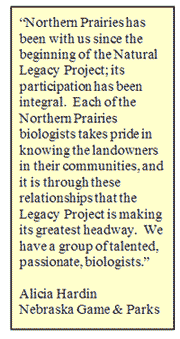
The first position was established in Beatrice, where the surrounding ranches include some of the last extensive examples of native tallgrasses, an essential habitat for a long list of native species. The challenge was enormous. Less than two percent of the tallgrass rairie remains in Nebraska and South Dakota. In its historic prime, tallgrasses supported some 1,500 species of plants, insects and animals, and stored vast amounts of carbon. Kent Pfeiffer, a veteran of plant and wildlife conservation took on this daunting assignment. The tallgrass prairies in his region were threatened by invasive cedar trees, which pushed-out the grasses and made the land less valuable for cattle grazing. However, by gaining the trust of landowners -- one at a time -- Kent was able to demonstrate that if landowners eradicate the invasive plants, the prairie can be restored to health, and support an economically productive grazing enterprise. Economics and the environment go together. Healthy prairie grasses support grazing while simultaneously restoring habitat for native species. In Kent’s words, “landowners come to realize that there is more to this land than what you can take off it. Work with nature.” Kent’s work is undramatic, requiring many small projects, visits, and trust-generating involvement. 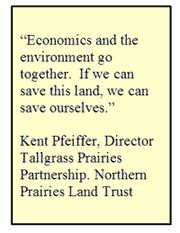
In recent years landowners have been plowing prairie grasses in order to grow corn -- an environmental catastrophe. Kent is able to report that the landowners with whom he works have been far less likely to plow their native grasses, simply because, with healthy grasses, they can make a good living grazing cattle.
Living in the community, bringing experience and knowledge to the task, and working with landowners one at a time, Kent is responsible for protecting many thousands of acres of prairie; restoring prairie on a landscape scale.
Community-based, voluntary land conservation. Protecting native prairie on a landscape scale.
Kelly Corman, based in Bassett, works in north central Nebraska, particularly along the Middle Niobrara and the Keya Paha River. His work is in one of the most diverse landscapes encountered by Northern Prairies biologists. He too is faced with the loss of tallgrass prairie to invasive red cedar trees, as well as conversion to corn, and works in the community, one landowner at a time, Kelly brings to his tasks a strong background in Colorado ranch land. The Keya Paha River, which flows into Nebraska from South Dakota, provides Kelly with an opportunity to work in partnership with conservationists in South Dakota. 
In recent years, Northern Prairies has expanded its conservation field work to encompass the oak woodlands along the eastern border of the state. James Baker is assigned to Ponca State Park, in the Ponca Hills BUL of northeastern Nebraska, along the Missouri River. Krista Lang and Jordan Marquis have similar duties, but in and around Indian Cave State Park, on the southern border. Just like the tallgrass prairie, the oak woodlands are under direct threat from a variety of invasive weeds, especially Garlic Mustard, which crept into the state’s woodlands in the last 5 years. Garlic mustard absolutely unhinges the entire ecosystem of the woodlands, killing the undergrowth, and defeating the natural ability of oak woodlands to reproduce.It is demanding work. According to Baker; “consistency is the key to controlling invasive species.” Working out from their bases on state parks, these woodland ecologists are engaging private owners of oak forest, getting out knowledge of garlic mustard, and encouraging private conservation projects. 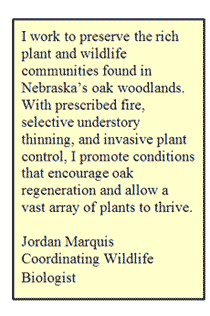 Their work in the oak woodlands accepts the challenge of ecological restoration and conservation on a landscape scale. Their work in the oak woodlands accepts the challenge of ecological restoration and conservation on a landscape scale.
In 2013 alone, our biologists brought about active conservation work on just under 39,000 acres of native ground. They are re-inventing conservation, one property at a time.
Supporting this innovative fieldwork presents daunting practical challenges for Northern Prairies, which remains at its core an all-volunteer organization. Innovation implies risk. Northern Prairies is taking risks because the opportunity for conservation on a landscape scale is too important.
We urge our friends to join us in supporting innovation.
President’s Message -- The Challenge to Conservation
These are challenging times for conservationists, as natural lands and waters are lost in ever greater amounts. The hard statistics are available. Between 2007 and 2012, 3, 150,000 acres of natural habitat were lost in Nebraska, and more than 2,172,000 in South Dakota. The eastern Dakotas are losing wetlands at a rate of 15,000 acres a year. Most of these losses are for purposes of increasing production of field crops such as corn and soybeans. Inevitably, the decline in populations of native birds accelerates on a parallel with loss of habitat.
Conservation organizations such as Northern Prairies Land Trust grew up in reliance on the strong land ethic of private landowners. At Northern Prairies we continue to believe that the land ethic is alive, but the startling changes in the landscape force us to consider new strategies. As we proceed to develop fresh ideas, we also realize a need to enlist new volunteers who will bring new ideas to our effort. Conservationists who read this are invited to consider volunteering. Never before has there been a greater need for the innovation, experience and creativity that only committed volunteers can provide.
Despite the jarring statistics of habitat loss, Northern Prairies continues to field four biologists in Nebraska who work with private landowners to implement conservation practices. These energetic, community-based biologists are managing to protect habitat on a landscape scale, offering a counterweight to the record of land loss. We also have active easement programs along the Missouri River and its tributaries. I invite you to contact our field biologists, get to know them, and view their achievements.
As we develop fresh strategies, we will publicize them through this internet site, and solicit your response and suggestions.
John Davidson
SERVING AS SOUTH DAKOTA’S ONLY GENERAL LAND TRUST
When Northern Prairies organized in 1999 there were no general land trusts in either South Dakota or Nebraska. Although there is now a second small land trust in Nebraska, Northern Prairies remains the only general land trust in South Dakota. This requires that we respond to inquiries from interested landowners across the State, providing the expertise needed to guide them to conservation solutions. In support of this responsibility, Northern Prairies was one of the first land trusts in the nation to be fully accredited by the Land Trust Accreditation Commission.
In addition to the many conservation easements held as part of the Big Sioux River Project, Northern Prairies has accepted and holds important easements elsewhere. On the Missouri National Recreational River, for example, it holds easements which protect some of the remaining intact bottomlands on this heavily-developed River.
Conservation Easements maintain a legacy
Fairbury, NE - Cattle will be grazing on the prairie hills southwest of Fairbury, Nebraska, for generations to come thanks to landowners interested in preserving the land for their family. In July of this year Jim and Ann McCord granted a 1043 Acre perpetual conservation easement to Northern Prairies Land Trust that would prohibit cropping and development, yet maintain the property as a working cattle ranch.
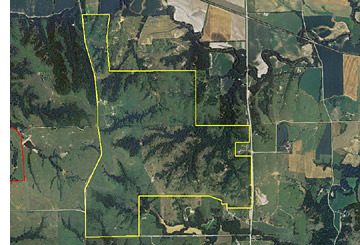 While the McCord property retains its value as a cattle pasture under the easement, it is also a precious natural resource in its own right. Native pastures in this area represent some of the most expansive examples of tallgrass prairie remaining in North America. Consequently, the prairies, oak woodlands, and wetlands that comprise the grazing lands of Jefferson and Thayer Counties have been designated as a high priority for conservation work under the Nebraska Natural Legacy Plan. These pastures, and the many species of plants and wildlife that depend of them, owe their survival to the thoughtful stewardship of families like the McCords. While the McCord property retains its value as a cattle pasture under the easement, it is also a precious natural resource in its own right. Native pastures in this area represent some of the most expansive examples of tallgrass prairie remaining in North America. Consequently, the prairies, oak woodlands, and wetlands that comprise the grazing lands of Jefferson and Thayer Counties have been designated as a high priority for conservation work under the Nebraska Natural Legacy Plan. These pastures, and the many species of plants and wildlife that depend of them, owe their survival to the thoughtful stewardship of families like the McCords.
By granting the easement to Northern Prairies Land Trust, the McCords have assured the continuation of a ranching legacy, while also protecting water resources, native prairie, and wildlife habitat.
Funding has been provided in part by a grant from the Nebraska Environmental Trust for work on private lands in southeast Nebraska; and the US Fish and Wildlife Service’s Landowner Incentive Program. These efforts assist private landowners with affecting landscape level change in southeast Nebraska for the benefit of a broad spectrum of wildlife species and their habitats.
Landowners and private contractors continue to make progress on Eastern red cedar tree removal projects in 2012. Thirteen areas, totaling 1,385 acres will be cleared to improve habitat for a number of at- risk wildlife species, including Greater Prairie Chicken, Regal Fritillary butterflies, Northern Bobwhite Quail, Loggerhead Shrike, and Bell’s Vireo, along with a variety of common species. These projects are in various stages of planning and completion. The Coordinating Wildlife Biologist continues to seek out additional landowners interested in improving their property to benefit wildlife species and improve grasslands and woodland habitats.

An on-going project involving Eastern red cedar tree removal on a mixed grass prairie (left).
A tree removal contractor completes cutting and piling on a project area in the Verdigris-Bazile BUL (right).
The Coordinating Wildlife Biologist, along with the Northeast Nebraska RC&D, Nebraska Game and Parks biologists, and Pheasants Forever biologists hosted a 5th annual Wildflower and Habitat Tour. Forty-six participants joined us for five stops across the Verdigris-Bazile, Lower Niobrara River, and Missouri River Biologically Unique Landscapes. Spectators received a behind the scenes look into how tree removal and prescribed fire practices can be used to manage and improve native grassland and woodland habitats. The effects of the widespread drought were also discussed, and it was evident that it had a dramatic impact on native habitats and cropland fields across the BULs. The tour wrapped up with a quick stop along the Missouri River to see how the 2011 flood has impacted the floodplain by creating vast sandbar habitat.

Participants of the Wildflower & Habitat Tour learn about prescribed fire and habitat management
on grasslands and oak woodlands (left). Tour participants get a hands-on look at a variety of native grasses
and wildflowers (center). Onlookers view the changes of the Missouri River following the 2011 flood (right).
The Coordinating Wildlife Biologist has been working with the University of Nebraska- Lincoln on an adaptive management study looking at tree removal in riparian forests along the lower reach of the Niobrara River. Pre-treatment vegetation data was gathered throughout the summer, and tree removal efforts are well under way in a number of the experimental plots. Data will continue to be collected during the summers of 2013 and 2014. This study will attempt to evaluate the effects of mechanically removing Eastern red cedar and other invasive woody trees and shrubs in riparian cottonwood and oak woodlands.

A cedar infested cottonwood forest along the Niobrara River. On the right, all cedars
have been removed from the understory of the same cottonwood forest, as part of a UNL research project.
.
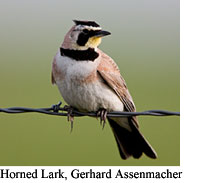
Conservation Innovation
Ducks Unlimited, along with its affiliated land trust, Wetlands America Trust (WAT) and Northern Prairies Land Trust teamed up to leverage additional conservation funding for South Dakota. Through funding provided for wind tower mitigation, Northern Prairies purchased a height restriction and conservation easement from WAT on 960 acres of land in McPherson County located within the 85th percentile of the identified whooping crane migration route.

Ducks Unlimited and WAT also pledged to use the funding
paid for the easement for additional conservation measures in South Dakota. Many times this funding is used as match for additional federal funds through habitat preservation programs, particularly the North American Wetlands Conservation Act, which supports the Prairies Without Borders project and the Harvey Dunn Grassland Preservation Project.
Local Riparian Easement Programs Rise Again
There are two riparian easement programs operating to protect the local watersheds. The programs involve both a revival of a proven program, the Big Sioux River Conservation Easement Program, now entitled East Dakota Riparian Restoration and Protection Project, (EDRRPP) and the initiation of a new program as part of the Central Big Sioux River Watershed Project.

EDRRPP was initiated by East Dakota Water Development District (EDWDD) and is sponsored by Northern Prairies with funding provided through EDWDD and the South Dakota Department of Environment and Natural Resources 319 grant program. It will cover the same nine-county area as EDWDD in eastern SD. The Central Big Sioux River Watershed Project is sponsored by the Moody County Conservation District, and Northern Prairies is assisting with the riparian easement aspect of that project. This project will cover the lower portion of the Big Sioux River Watershed, and offers a variety of conservation practices in addition to easements.
.
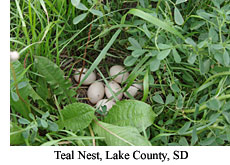 First Central Big Sioux Riparian Easement First Central Big Sioux Riparian Easement
The first riparian easement in the Central Big Sioux River Watershed Project was granted in February on property in Minnehaha County. The Big Sioux River runs through the heavily wooded portion of this property and is subject to significant erosion problems. By agreeing to incorporate the protective buffer the landowner is taking action to help improve water quality in an area just upstream from South Dakota's largest city, Sioux Falls. The easement was purchased with funding from Sioux Falls
.
.
Scenic Photos

Carbon Containment in the Tallgrass Prairie
John H. Davidson, President of Northern Prairies, authored an article entitled “North America’s Great Carbon Ocean”, which is published in the Winter 2010 edition of Saving Land, the quarterly publication of the Land Trust Alliance. Click here to read more. |
How Important is the Tallgrass Prairie?
 The Value of Green Space The Value of Green Space
 Recent publications have outlined health and well-being benefits of green space and commons in urban landscapes as well as the economic paybacks of parks and open space. Case studies are contained in Restorative Commons: Creating Health and Well-Being through Urban Landscapes, edited by Lindsey Campbell and Anne Wiesen, published by USDA Forest Service at www.nrs.fs.fed.us/pubs/8810 , or additional copies can be obtained from USDA Forest Service, Publications Distribution, 359 Main Rd, Delaware, OH 43015, and Fax: (740) 368-0152. The Trust for Public Lands just released Conservation: An Investment That Pays; The Economic Benefits of Parks and Open Space; available at their web site www.tpl.org . Recent publications have outlined health and well-being benefits of green space and commons in urban landscapes as well as the economic paybacks of parks and open space. Case studies are contained in Restorative Commons: Creating Health and Well-Being through Urban Landscapes, edited by Lindsey Campbell and Anne Wiesen, published by USDA Forest Service at www.nrs.fs.fed.us/pubs/8810 , or additional copies can be obtained from USDA Forest Service, Publications Distribution, 359 Main Rd, Delaware, OH 43015, and Fax: (740) 368-0152. The Trust for Public Lands just released Conservation: An Investment That Pays; The Economic Benefits of Parks and Open Space; available at their web site www.tpl.org .
HOW FINE-TUNED ARE YOUR BIRD IDENTIFICATION SKILLS?
 Gerhard Assenmacher, a landowner in south-central Nebraska, who donated a conservation easement to Northern Prairies, has photographed a wonderful collection of birds located on his property. Click here to see how many you can identify. Gerhard Assenmacher, a landowner in south-central Nebraska, who donated a conservation easement to Northern Prairies, has photographed a wonderful collection of birds located on his property. Click here to see how many you can identify.
.
|
For more information, please contact the nearest office listed under the “Contact Us” tab at the top |
|